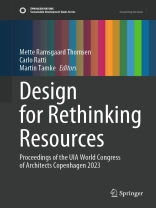The book provides new perspectives from leading researchers accentuating and examining the central role of the built environment in conceiving and implementing multifaceted solutions for the complex challenges of our understanding of planetary resources and circularity, revealing critical potentials for architecture and design to contribute in more informed and long-term ways to the urgent transition of our society. The book offers a compilation of peer-reviewed papers that uniquely connects knowledge broadly across practice and academia; from the newest technologies and methods such as the role of digital modelling, analysis, and fabrication in circular design, i.e. material passports, cyber-physical augmentation, and LCA to the potentials of growing and harvesting biomass materials, engaging waste streams in material production and more, all in context of economic, social, and ecological potentials and consequences.
The book is part of a series of six volumes that explore the agency of the built environment in relation to the SDGs through new research conducted by leading researchers. The series is led by editors Mette Ramsgaard Thomsen and Martin Tamke in collaboration with the theme editors:
- Design for Climate Adaptation: Billie Faircloth and Maibritt Pedersen Zari
— Design for Rethinking Resources: Carlo Ratti and Mette Ramsgaard Thomsen (Eds.)
— Design for Resilient Communities: Anna Rubbo and Juan Du (Eds.)
— Design for Health: Arif Hasan and Christian Benimana (Eds.)
— Design for Inclusivity: Magda Mostafa and Ruth Baumeister (Eds.)
— Design for Partnerships for Change: Sandi Hilal and Merve Bedir (Eds.)
Содержание
Introduction.- Rethinking Resource and Inclusivity.- Local Resource and Fabrication.- Material.- Assembly Futures.- Renewables.- Rethinking Waste.












